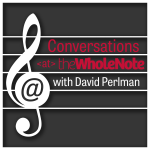Measha's Back
When CBC personality Gian Ghomeshi asked Measha Brueggergosman “How are you feeling?” during an onstage interview at the soprano’s October 17 recital at St. Andrew’s Presbyterian, he wasn't just making small talk.
A Brave New World for Early Music
My very photogenic gamba was photographed myriad times during Nuit Blanche, late Saturday night, as it contributed its voice to the general sound vibrating through the lobbies, corridors, atrium and concert hall of the stunning new facility at Toronto’s Royal Conservatory of Music.
On the Sound-Road of Nuit Blanche
Massey Hall, the grand dame of Victoria Street, was transformed during Toronto’s Nuit Blanche into a sound installation and performance art work. This transformation was care of the composer-sound artist Gordon Monahan, the pride of not only Meaford, Ontario, but also of Berlin, Germany. Judging from the size of the crowd and by the attentiveness of the listeners once they were safely sitting in the hall, Monahan’s work was evidently one of the hits of Nuit Blanche.
A Beautiful Tribute to a Forty-Year-Old
Unbelievable as it may seem to those of us who remember it as if it were yesterday, the Beatles’ Abbey Road came out 40 years ago. Wasn’t it just last week that we were sitting in a friend’s basement having our little minds blown by “I Want You (She’s So Heavy)” and “Oh! Darling”?
Gallery Goldbergs
Pianist Dan Tepfer was at Gallery 345 on September 14 – as were about 60 musical cognoscenti, who came out to hear Bach’s Goldberg Variations. And perhaps there was someone else present, at least in spirit.
If Glenn Gould were looking down on the event he’d have immediately recognized his own stage mannerisms: Tepfer likes to hum along while leaning precariously into the keyboard. But Gould’s ghost would have been surprised by Tepfer’s take on the Goldbergs. At 27, this French-born American is both a classical and jazz musician – and his performance was a mixture of movements played “straight” and his own improvised interpretations.
Websites that Work
Much has been written about how classical music has taken to the internet like a fish to water. That may be true – but it seems that some of the fish are better swimmers than others.
I know this because I spent an entire afternoon looking up prominent Canadian performers, to see who's got a website and who's got a good website. The first thing I found when I started Googling our nation's foremost classical soloists and chamber groups is that most of these artists are well promoted on their managers' websites. That sort of initiative has its place, to be sure – but what I was really looking for were websites created by (or at least apparently created by) the musicians themselves.



